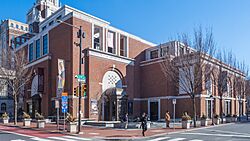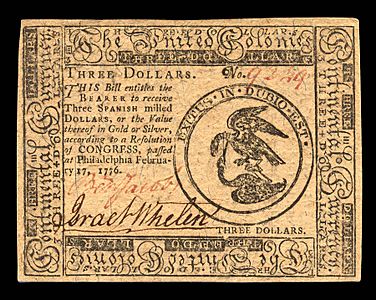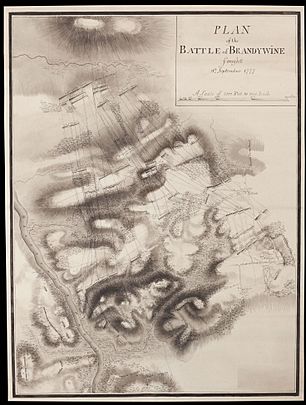Museum of the American Revolution facts for kids
 |
|

Museum of the American Revolution in Philadelphia
|
|
| Established | 2000 April 19, 2017 |
|---|---|
| Location | 101 S. Third St., Philadelphia, Pennsylvania, U.S. |
| Type | History museum |
| Collection size | 3,000 |
| Public transit access | |
The Museum of the American Revolution is a special place in Philadelphia, Pennsylvania. It tells the amazing story of the American Revolution. This was when America fought for its freedom. The museum opened its doors on April 19, 2017. This date was the 242nd anniversary of the Battles of Lexington and Concord. These were some of the first battles of the American Revolutionary War in 1775.
The museum is located at 101 South Third Street in Philadelphia. This city was the capital during America's founding. The museum is close to many important historical sites. These include the First Bank of the United States and Independence Hall. It is also near the Liberty Bell.
Contents
Exploring the American Revolution Museum
The museum has a large collection of thousands of items. These include old artwork, sculptures, and clothing. There are also weapons, old letters, and rare books. The museum uses these items to show how the American Revolution happened. It also helps visitors understand why it is still important today.
Gerry Lenfest, a generous person from Philadelphia, helped start the museum. He was the chairman of the board from 2005 to 2016. Dr. R. Scott Stephenson became the president and CEO in November 2018. Morris W. Offit is the current chairman.
Building the Museum: Design and Construction
The museum building was designed by Robert A.M. Stern Architects. Robert A. M. Stern showed the plans for the museum on June 12, 2012. Construction on the museum began in the fall of 2014.
The building has three floors above the street. It also has a full basement. In total, it is 118,000 square feet. About 32,000 square feet are used for exhibits. The first floor has a museum shop and a cafe. The cafe opens right onto the sidewalk. Inside, the first floor has a bright central court. It also has a ticket lobby and a theater. There is also a gallery for changing exhibits.
The second floor has 18,000 square feet of galleries. It also has a special theater. This theater shows George Washington's famous tent. The third floor has rooms for events. It also has two terraces with great views. From here, you can see the First Bank of the United States. You can also see Independence National Historical Park and the Philadelphia skyline. The museum aims to be very energy efficient.
The Outdoor Plaza
The museum's outdoor plaza opened on September 25, 2016. It is open to both museum visitors and people walking by. The plaza has cool displays of Revolutionary War items. It also has bronze sculptures and shaded seating. During certain seasons, you can also find cafe seating there.
How People Liked the Museum When It Opened
When the museum opened on April 19, 2017, most people really liked it. Historians praised the museum for its detailed and easy-to-understand story. It covered the war, society, and the revolution's lasting impact. Jennifer Schuessler from The New York Times liked how the museum showed the revolution's complex history. She also liked its focus on everyday people.
Edward Rothstein from The Wall Street Journal had mixed feelings. He liked the history but felt it made the revolution seem less sacred. George Will from The National Review praised the museum for celebrating the revolution. He also noted how it showed the violence involved. Inga Saffron from The Philadelphia Inquirer liked the exhibits. However, she thought the building's design had too many empty rooms. She believed these were for private events.
Museum Exhibits
Visitors at the museum follow a journey through time. It starts with the reasons for conflict in the 1760s. Then it moves to the start of fighting and the Declaration of independence in 1776. Finally, it covers the last years of the war. Visitors learn about the many different kinds of people during the revolution. For example, they can see an Oneida Indian council house. They can also see a book of poems from 1773 by Phillis Wheatley. She was America's first published Black female poet.
Some exhibits are very immersive. There is a full-size copy of Boston's Liberty Tree. You can also see a recreated Oneida Indian Council. The Battlefield Theater shows the Battle of Brandywine. There is also a copy of Independence Hall. A large model of an 18th-century privateer ship is also on display. A special theater holds a very important item: General Washington's Headquarters Tent. This tent was his office and sleeping place during much of the war.
Dr. R. Scott Stephenson is the museum's president and CEO. He has a Ph.D. in American History. He is an expert in early American history. Dr. Philip C. Mead is the Chief Historian and Curator. He has a Ph.D. in American History from Harvard University.
In February 2023, the museum opened a new exhibit. It is called "Black Founders: The Forten Family of Philadelphia." This exhibit is 5000 square feet. It focuses on James Forten, a Black Founding Father. He was also an abolitionist. The exhibit tells the story of his family's fight for voting rights and freedom for African Americans.
Museum Collection Highlights
The Museum of the American Revolution has thousands of objects. The collection includes items owned by General George Washington. These were used during the War of Independence. There are also many old firearms and swords. Important art, old letters, and rare books are also part of the collection. The core of the collection came from Rev. W. Herbert Burk in the early 1900s.
Some items from the museum have been shown in other places. These include George Washington's Mount Vernon. They have also been at Valley Forge National Historical Park.
Here are some special items in the collection:
- George Washington's tent
- Silver cups from Washington's field equipment
- Letters and books from Washington's library
- The thirteen-star flag, also known as the Commander-in-Chief's Standard
- A hunting gun carried by Captain David Brown. He led minutemen from Concord, Massachusetts.
- A British military musket carried by a soldier. Both participated in the first battle of the war.
- A Dreadful Scene of Havock, a painting of the Battle of Paoli
- The Battle of Germantown, a painting by Xavier della Gatta (1782)
- William B. T. Trego’s famous 1883 painting The March to Valley Forge
- Soldiers’ letters and books. Also, books owned by Patrick Henry and George Mason.
- A book of ancient Roman history owned by George Mason.
- A copy of the first newspaper printing of the Declaration of Independence. It was printed on July 6, 1776.
- A British plan of the Battle of Brandywine
- Hessian headgear (hats)
Selections from the Collection
-
Continental Currency (1776)
-
First newspaper printing of the Declaration of Independence, Pennsylvania Evening Post (1776)
-
Plan of the Battle of Brandywine (1777)
Museum Awards and Recognition
The Museum of the American Revolution has won many awards. These awards recognize its great exhibits and programs.
- In 2012, it won a MUSE Award for its iPad app.
- In 2017, it won a Pennsylvania Historic Preservation Award. This was for Washington's War Tent.
- It was nominated for "Best New Cultural Destination" in North America in 2017.
- It received an Award of Merit from the British Guild of Travel Writers in 2017.
- In 2018, it won an Excellence in Exhibition Award. This was for helping people learn new things about topics they thought they knew.
- It also won the PA Museums' Institutional Award for Washington's War Tent in 2018.
- In 2019, it won an award for its "Revolution Place" discovery center. This center helps kids learn about the revolution.
- The museum also won an award for Sustainability in 2019.
- In 2020, it won awards for its special exhibit Hamilton Was Here.
- In 2021, it won a MUSE Award for its "Finding Freedom" Online Experience.
- Its redesigned website, AmRevMuseum.org, was honored by the Webby Awards in 2021.
- In 2021, it won awards for its Cost of Revolution special exhibit.
- In 2022, it won a Silver-Level Anthem Award for "Finding Freedom" Online Experience.
- It also won awards in 2022 for its "When Women Lost the Vote" special exhibition.
- In 2023, it received a PA Museum’s Special Achievement Award for its Liberty special exhibit.
- It was a Webby Awards Nominee in 2023 for its Virtual Tour of Washington’s Field Headquarters.
See also






